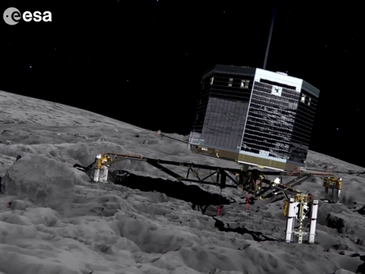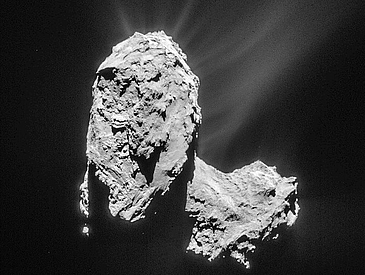On November 12, 2014, the Rosetta space probe landed the PHILAE module on the surface of Comet 67P/Churyumov-Gerasimenka, Tschuri for short – after an eleven-year odyssey through outer space. On board is an instrument that goes by the name of COSAC (Cometary Sampling and Composition Experiment). This sophisticated piece of equipment was co-designed by Bremen researchers Wolfram Thiemann, Uwe Meierhenrich (now University of Nizza) and JanHendrikBredehöft in collaboration with the Max Planck Institute for Solar System Research in Göttingen. PHILAE is designed to explore the comet surface and search for signs of organic molecules. On July 31, 2015, the first results obtained from COSAC were published by the journal SCIENCE in an article with the title “Organic compounds on comet 67P/Churyumov-Gerasimenko revealed by COSAC mass spectrometry”. The 21 co-authors present evidence of 16 different types of organic molecules found on the Tschuri. JanHendrikBredehöft and Wolfram Thiemann from the University of Bremen’s Institute of Applied Physical Chemistry played an important role in compiling the article. According to Professor Wolfram Thiemann, “The data provide clear indication that these molecules are small fragments of amino acids in the soil“. Amino acids are crucial components of proteins, which in turn form the basic building blocks of cells and, hence, the origin of all forms of life.
Notwithstanding, the data collected so far are still not considered to be conclusive evidence of the existence of life-giving matter outside Earth. The researchers therefore hope that COSAC will be able to take samples from deeper under the surface and supply further information on possible signs of life.
Click here for more information on the Rosetta Space Mission.
http://www.uni-bremen.de/no_cache/en/latest-news/single-view/news/detail/News/rosetta-mission-nerve-racking-suspense-for-bremen-researchers.htmlSCIENCE article describes initial results
The article in SCIENCE contains a description of what is known so far, based on initial analysis of dust particles identified by a mass spectrometer. There is clear evidence that these samples contain at least 16 different types of organic molecules. Beside the most important molecule water, they include relatively simple molecules containing carbon, hydrogen, and oxygen like methane, carbon monoxide, acetaldehyde, acetone, propionaldehyde, glykolaldehyde and 1.2-ethylenglycole. Interestingly, analysis has revealed chemical compounds like prussic acid, methylamine, acetonitrile, isocyanic acid, formamide, ethylamine, methylisocyanat and acetamide that also contain the important element nitrogen.
Yet, scientists still have no positive proof of the existence of living matter on Tschuri. And due to insufficient power, the PHILAE landing module has so far been unable to perform its most important task: It was not only intended to analyze dust deposits on the surface of the comet, but also any amino acids and similar molecules in soil samples taken from a depth of up to 20 centimeters. This was to be carried out by means of gas chromatographs and mass-spectrometric detection and, the Bremen scientists hope, provide additional information on “chirality” (handedness).
However, they still haven’t given up all hope that PHILAE can be reactivated. By mid-August Tschuri will be much nearer to the sun and able to recharge its solar batteries. Then it may well be possible to deliver the eagerly awaited analytical data.
What does chirality mean?
The term chirality describes a well-known phenomenon of biomolecules, which are composed of components that are either completely right-handed or completely left-handed. Proteins, for example, are built solely of L-amino acids, and their mirror images, D-amino acids, are completely absent. Similarly, carbohydrates and DNA use exclusively D-sugar and have no use for units of L-sugar. A central question puzzling science is how at the start of biological evolution the right/left symmetry was broken so that the molecular building blocks of life can produce either in the right or the left form. Today, scientists have reason to believe that this break of symmetry did not take place on Earth at all, but rather in interstellar space. In this case, molecules like amino acids or sugar that exhibit the phenomenon of handedness (Greek: chirality) must be present in the comet material in the right or the left form in dissimilar quantities.
For more information on this topic, contact:
University of Bremen
Faculty of Biology / Chemistry
Prof.Dr. Wolfram Thiemann
Phone: +49 421-218-63211
Phone: +49 421 71270
e-mail: thiemannprotect me ?!uni-bremenprotect me ?!.de


